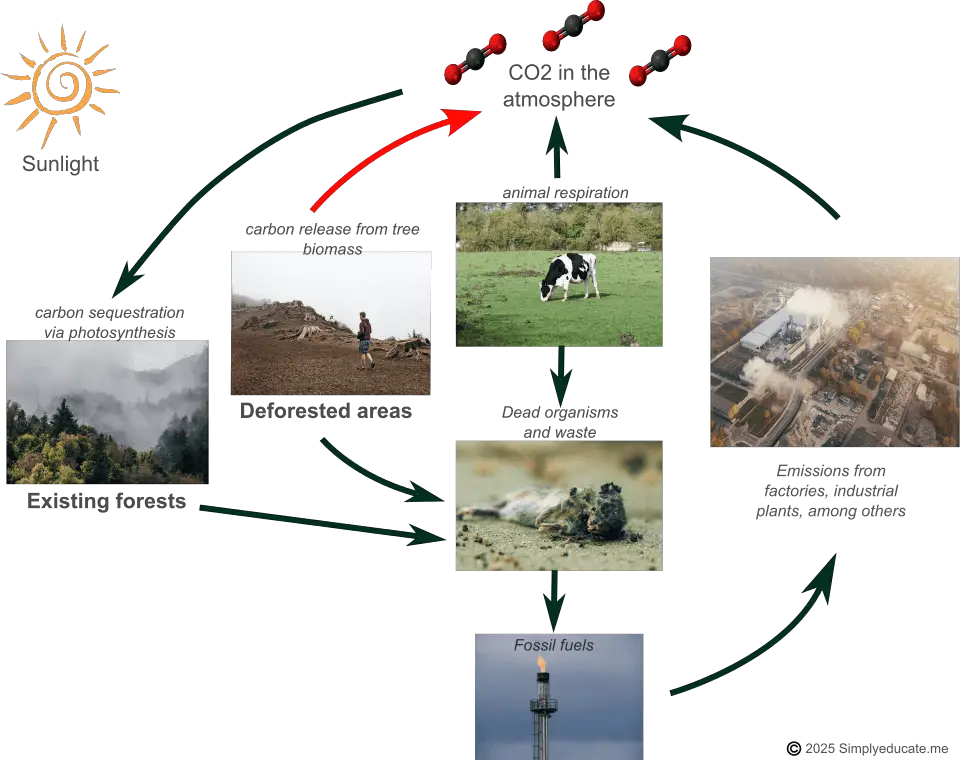
Table of Contents
How does deforestation contribute to climate change? This article sheds light on why large scale cutting of trees, agricultural expansion, logging, infrastructure development, among others can have significant effects to global climate.
For us to have a common understanding of what deforestation means, there is a need to define the terms that we are using here. I therefore see the need to define deforestation first and enumerate the primary causes of deforestation before discussing its effects on global climate.
Also, in this article, the discussion will focus on deforestation and its relationship to climate change.
Let’s begin.
What is deforestation?
Deforestation, a critical environmental issue, refers to the large-scale clearing of forests, leading to the permanent removal of trees and vegetation. This process can drive climate change, loss of biodiversity, and threaten the livelihoods of local communities.
Deforestation refers to the large-scale clearing of forests, leading to the permanent removal of trees and vegetation.
Being aware of the concept of deforestation is crucial for individuals of all ages, as it directly affects our planet’s health and future. By grasping the causes and consequences of deforestation, we can make informed decisions to protect our forests and wildlife.
In the following sections, we will look into the specific factors that contribute to deforestation and explore how human intervention can play a pivotal role in mitigating this pressing issue.
Find out how we can collectively address and combat deforestation for a more sustainable future.
What causes deforestation?
Deforestation is a complex issue influenced by a variety of factors that have significant implications for our environment and society. Identifying these factors is crucial in addressing and combating the destructive effects of deforestation.
Let’s explore the key drivers behind deforestation and how human intervention can play a pivotal role in managing and mitigating these factors.
1. Agricultural expansion
One of the primary factors that lead to deforestation is agricultural expansion. As the global population continues to grow, the demand for food increases, putting pressure on land resources.
To meet this demand, forests are often cleared to make way for agricultural activities such as large-scale farming and livestock grazing. This conversion of forested areas into agricultural land not only results in the loss of valuable ecosystems but also contributes to biodiversity loss and habitat destruction.
2. Unsustainable logging activities
Another significant factor driving deforestation is logging activities. Timber extraction for commercial purposes, whether for construction, paper production, or furniture manufacturing, leads to extensive tree felling.
If logging is done correctly, like having portions of the forest cleared at a time. We call this selective logging or partial cutting. This practice allows forest regeneration.
However, unsustainable logging practices, such as clear-cutting, where entire sections of forests are cut down, can have devastating consequences on forest ecosystems. It disrupts the natural balance, reduces forest resilience, and accelerates soil erosion.
Thus, forests may not recover if propagules from nearby forests are not able to resettle in the cleared areas. Animals as agents of pollination and dispersion of seeds play a significant role in natural regeneration. But if these animals are not able to survive clear cutting, there will be no way such forests could recover.
3. Infrastructure development
Infrastructure development plays a crucial role in deforestation. The construction of roads, dams, and urban areas often requires clearing large tracts of forested land.
This fragmentation of forests not only directly removes trees but also creates pathways for further human encroachment into pristine forest areas. This is a real scenario in largely forest dependent populations as there is not enough enforcement to prevent this from happening.
For example, burning of forests referred to as slash-and-burn farming or kaingin, is a common practice of isolated indigenous communities who for centuries have been doing this as part of their culture. This cultural practice appears to be sustainable as it is mainly done for subsistence.
But for lowlanders aiming to establish farms for commercial purposes and economic gain, kaingin may pose a significant threat to intact ecosystems. Cleared pathways due to infrastructure development provides opportunities for forest exploitation.
Further, forest fragmentation can isolate wildlife populations, disrupt migration patterns, and increase the risk of species extinction. If the forest is not able to maintain balance due to its inability to carry on its sustaining ecosystem functions, then it will no longer recover as it should.
4. Climate change
Climate change itself is exacerbating deforestation. Rising temperatures, altered precipitation patterns, and increased frequency of extreme weather events are putting additional stress on forests worldwide.
Forests are vital in regulating the climate by absorbing carbon dioxide, a greenhouse gas that contributes to global warming. Deforestation disrupts this critical function, leading to increased carbon emissions and further exacerbating climate change.
In essence, there is a feedback loop between deforestation and climate change. If something goes wrong with the vital function of forests, the climate is affected. The change in climate also affects the regulating function of the forests. It’s a cycle.
I shall discuss this further in the next section.
Deforestation Statistics of Nations with Vast Forested Areas
When examining deforestation statistics, it becomes evident that several countries around the world are facing significant challenges due to the extensive loss of their forests. Among the nations with vast forested areas that are being deforested at alarming rates are Brazil, Indonesia, and the Democratic Republic of Congo. These countries are experiencing high levels of deforestation primarily due to agricultural expansion, logging activities, infrastructure development, and mining operations.
Brazil Deforestation
Brazil, home to the Amazon rainforest, one of the most biodiverse regions on the planet, has been grappling with substantial deforestation rates driven by the expansion of agricultural activities, particularly cattle ranching and soy production. The clearing of land for these purposes has led to widespread forest destruction, impacting not only the local ecosystem but also contributing significantly to global carbon emissions.
According to Global Forest Watch, as of 2020, natural forests covered over 60% of Brazil’s land area. After four years (2020 to 2024), 4.44 million hectares (MHa) of the original 511 MHa of natural forest were lost—resulting in approximately 1.82 gigatons (Gt) of CO₂ emissions released into the atmosphere. A gigaton (Gt) is equivalent to one billion metric tons. Imagine how massive that is.
Democratic Republic of the Congo Deforestation
The Democratic Republic of Congo, home to the second-largest rainforest in the world after the Amazon, is experiencing deforestation primarily due to logging activities, subsistence agriculture, and infrastructure projects. The exploitation of timber resources, coupled with the conversion of forested areas into agricultural lands, poses a threat to the rich biodiversity of the region and contributes to the release of stored carbon into the atmosphere.
Global Forest Watch reports that the Democratic Republic of the Congo had 160 million hectares (MHa) of natural forest in 2020, accounting for over 69% of its land area. After four years, 1.22 MHa were lost to deforestation—equivalent to 824 million metric tons (Mt) of CO₂ emissions.
Indonesia Deforestation
Indonesia, known for its lush tropical forests, is also facing severe deforestation challenges, mainly driven by the palm oil industry. Large-scale clearing of forests to make way for oil palm plantations has resulted in the loss of critical habitats for endangered species, increased greenhouse gas emissions, and heightened risks of wildfires during dry seasons.
Related Article: Four reasons why we should save endangered species.
According to Global Forest Watch, as of 2020, Indonesia had 93.8 million hectares (MHa) of natural forest, which accounted for over 50% of its land area. After four years, 259 thousand hectares (kHa) were lost to deforestation—resulting in an estimated 194 million metric tons (Mt) of CO₂ emissions.
How does deforestation contribute to climate change?
Deforestation plays a significant role in exacerbating climate change, impacting the delicate balance of the carbon dioxide cycle. Forests act as crucial carbon sinks, absorbing carbon dioxide from the atmosphere during photosynthesis.
Let’s see how the carbon dioxide cycle works and how deforestation disrupts the natural cycle using a simplified diagram.

Trees absorb carbon dioxide from the atmosphere through photosynthesis. During this process, they combine carbon dioxide and water, using sunlight to produce sugars (carbohydrates) and release life-sustaining oxygen. This natural process is now widely known as carbon sequestration. However, when trees are cut down or burned during deforestation, the carbon stored in their biomass is released back into the atmosphere, intensifying the greenhouse effect and contributing to global warming.
The loss of trees reduces the planet’s capacity to absorb carbon dioxide, leading to higher concentrations of this greenhouse gas in the atmosphere. This increase in carbon dioxide levels traps heat, causing temperatures to rise and resulting in various climate-related consequences such as more frequent and severe natural disasters, altered weather patterns, and disruptions to ecosystems.
Let’s examine the impacts of deforestation in more detail in the next section.
Global impacts of deforestation on climate
Large-scale deforestation has profound global impacts on the climate, affecting countries prone to significant changes in weather patterns. The removal of vast forested areas disrupts the delicate balance of ecosystems, leading to a cascade of environmental consequences. One of the primary ways deforestation influences climate change is through the alteration of local and regional weather patterns.
Let’s see how deforestation can alter local and regional weather patterns.
Alteration of local and regional weather patterns
Increased temperatures in affected areas
Forests play a crucial role in regulating temperature and precipitation levels through processes such as evapotranspiration, where trees release water vapor into the atmosphere. When forests are cleared on a large scale, this natural cooling mechanism is disrupted, leading to increased temperatures in the affected areas.
Reduced capacity of the land to absorb and store water
The loss of tree cover also reduces the capacity of the land to absorb and store water, contributing to changes in rainfall patterns and potentially leading to more frequent and severe droughts or floods.
Release of significant amounts of carbon dioxide
Deforestation releases significant amounts of carbon dioxide into the atmosphere, a major greenhouse gas that contributes to global warming. Trees act as carbon sinks, absorbing CO2 during photosynthesis and storing it in their biomass.
When forests are cleared or burned, the carbon sequestered in biomass and soil is released into the atmosphere as carbon dioxide (CO₂), a potent greenhouse gas. This release contributes significantly to the intensification of the greenhouse effect, thereby accelerating global climate change.
The greenhouse effect is intensified by the emission of carbon dioxide (CO₂) that leads to global warming and broader climate change. Elevated global temperatures can alter precipitation regimes, resulting in more frequent and severe droughts, intensified storm systems, and irregular seasonal patterns.
Economic impacts of deforestation
Deforestation not only has significant environmental impacts but also profound economic consequences. The long-term effects of deforestation on the economy are far-reaching and multifaceted, affecting various sectors and aspects of society.
Decreased agricultural productivity
One of the primary economic impacts of deforestation is the loss of ecosystem services that forests provide. Forests play a crucial role in supporting agriculture, providing clean water, and regulating climate patterns, all of which are essential for economic activities.
When forests are cleared, these ecosystem services are compromised, leading to decreased agricultural productivity, increased water pollution, and heightened vulnerability to climate-related disasters. This, in turn, can have detrimental effects on local economies that rely on these services for sustenance and growth.
Job loss, reduced income opportunities, and increased poverty levels
Deforestation can disrupt local economies that depend on forest resources for livelihoods. Many communities around the world rely on forests for timber, non-timber forest products, and ecotourism, among other things. The loss of forests can result in the depletion of these resources, leading to job losses, reduced income opportunities, and increased poverty levels.
In regions where forestry is a significant economic sector, deforestation can have severe implications for the well-being of communities and the overall economic stability of the area.
Increased price of commodities
Deforestation can impact global markets and trade dynamics. The destruction of forests can lead to changes in commodity prices, particularly for products like timber, palm oil, and soy, which are major drivers of deforestation.
As supply chains become disrupted and production costs increase due to environmental degradation, the economic repercussions can be felt on a global scale.
Furthermore, deforestation can trigger regulatory responses and trade restrictions aimed at curbing unsustainable practices, further affecting international trade and economic relations.
How can we stop deforestation?
To mitigate the climate effects of deforestation, it is crucial to implement strategic steps that address the root causes of forest loss and promote sustainable land management practices. By taking proactive measures, we can work towards preserving our forests and combating climate change effectively.
Implement sustainable agriculture techniques
When it comes to factors that can be controlled by humans through management, agricultural practices stand out. Implementing sustainable agriculture techniques, such as agroforestry and organic farming, can help reduce the pressure on forests for agricultural expansion. By promoting practices that maintain soil health, preserve biodiversity, and minimize chemical inputs, we can protect existing forests and promote sustainable land use.
Promote sustainable forestry management
Sustainable forestry management is essential in controlling deforestation caused by logging activities. Adopting selective logging practices, establishing protected areas, and enforcing regulations to prevent illegal logging can help maintain forest cover while supporting the timber industry in a sustainable manner.
Encouraging agroforestry, sustainable logging techniques, and land-use planning that prioritizes forest conservation can help reduce the pressure on forests and promote ecosystem health. By integrating sustainable practices into agricultural and forestry activities, we can strike a balance between economic development and environmental protection.
Certification schemes like the Forest Stewardship Council (FSC) promote responsible forestry practices and help consumers make environmentally conscious choices.
Implement robust conservation policies and regulations
Another key step to mitigate deforestation is the implementation of robust conservation policies and regulations. Governments and international organizations play a vital role in establishing and enforcing laws that protect forests from illegal logging, land conversion, and unsustainable agricultural practices.
By creating a legal framework that incentivizes responsible forest management and penalizes destructive activities, we can safeguard our forests for future generations.
Promote reforestation and afforestation
Another essential strategy is to promote reforestation and afforestation initiatives. By planting trees in deforested areas or restoring degraded forests, we can enhance carbon sequestration, improve biodiversity, and restore ecosystem services. Reforestation projects not only help offset carbon emissions but also contribute to local livelihoods, biodiversity conservation, and climate resilience.
Educate and enhance awareness on deforestation and its effects
Education and awareness-raising also play a significant role in mitigating deforestation. By educating communities, policymakers, and businesses about the importance of forests, the value of ecosystem services, and the benefits of sustainable land management, we can foster a culture of conservation and responsible stewardship. Empowering individuals and organizations to make informed decisions about forest conservation is key to achieving long-term sustainability goals.
Conclusion
Deforestation is a multifaceted issue driven by various factors, including agricultural expansion, logging activities, infrastructure development, and climate change. While some of these factors may seem daunting, human intervention through sustainable land management practices and responsible forestry can make a significant difference in combating deforestation and preserving our precious forests for future generations.
Mitigating the climate effects of deforestation requires a combination of policy interventions, reforestation efforts, sustainable land-use practices, and education. By working together to protect and restore our forests, we can mitigate the negative impacts of deforestation on the climate, biodiversity, and human well-being, ensuring a more sustainable future for all.


